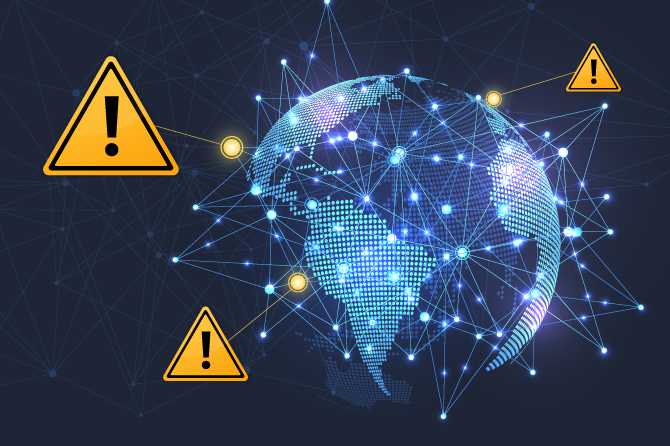
Verisign Domain Name Industry Brief: 349.9 Million Domain Name Registrations in the Third Quarter of 2022
Today, we released the latest issue of The Domain Name Industry Brief, which shows that the third quarter of 2022 closed with 349.9 million domain name registrations across all top-level domains, a decrease of 1.6 million domain name registrations, or 0.4%, compared to the second quarter of 2022.1,2 Domain name registrations have increased by 11.5 million, or 3.4%, year over year.1,2
(more…)
Celebrating 35 Years of the DNS Protocol
In 1987, CompuServe introduced GIF images, Steve Wozniak left Apple and IBM introduced the PS/2 personal computer with improved graphics and a 3.5-inch diskette drive. Behind the scenes, one more critical piece of internet infrastructure was quietly taking form to help establish the internet we know today.
(more…)
Verisign Q2 2022 Domain Name Industry Brief: 351.5 Million Domain Name Registrations in the Second Quarter of 2022
Today, we released the latest issue of The Domain Name Industry Brief, which shows that the second quarter of 2022 closed with 351.5 million domain name registrations across all top-level domains, an increase of 1.0 million domain name registrations, or 0.3%, compared to the first quarter of 2022.1,2 Domain name registrations have increased by 10.4 million, or 3.0%, year over year.1,2
(more…)
ICANN’s Accountability and Transparency – a Retrospective on the IANA Transition
As we passed five years since the Internet Assigned Numbers Authority transition took place, my co-authors and I paused to look back on this pivotal moment; to take stock of what we’ve learned and to re-examine some of the key events leading up to the transition and how careful planning ensured a successful transfer of IANA responsibilities from the United States Government to the Internet Corporation for Assigned Names and Numbers. I’ve excerpted the main themes from our work, which can be found in full on the Internet Governance Project blog.
(more…)
Verisign Q1 2022 Domain Name Industry Brief: 350.5 Million Domain Name Registrations in the First Quarter of 2022
Today, we released the latest issue of The Domain Name Industry Brief, which shows that the first quarter of 2022 closed with 350.5 million domain name registrations across all top-level domains, an increase of 8.8 million domain name registrations, or 2.6%, compared to the fourth quarter of 2021.1,2 Domain name registrations have increased by 13.2 million, or 3.9%, year over year.1,2
(more…)
Celebrating Women Engineers Today and Every Day at Verisign
Today, as the world celebrates International Women in Engineering Day, we recognize and honor women engineers at Verisign, whose own stories have helped shape dreams and encouraged young women and girls to take up engineering careers.
Here are three of their stories:
(more…)
More Mysterious DNS Root Query Traffic from a Large Cloud/DNS Operator
This blog was also published by APNIC.
With so much traffic on the global internet day after day, it’s not always easy to spot the occasional irregularity. After all, there are numerous layers of complexity that go into the serving of webpages, with multiple companies, agencies and organizations each playing a role.
That’s why when something does catch our attention, it’s important that the various entities work together to explore the cause and, more importantly, try to identify whether it’s a malicious actor at work, a glitch in the process or maybe even something entirely intentional.
(more…)
Verisign Q4 2021 The Domain Name Industry Brief: 341.7 Million Domain Name Registrations in the Fourth Quarter of 2021
Today, we released the latest issue of The Domain Name Industry Brief, which shows that the fourth quarter of 2021 closed with 341.7 million domain name registrations across all top-level domains, an increase of 3.3 million domain name registrations, or 1.0%, compared to the third quarter of 2021.1,2 Domain name registrations have increased by 1.6 million, or 0.5%, year over year.1,2
(more…)
Routing Without Rumor: Securing the Internet’s Routing System
The Domain Name System has provided the fundamental service of mapping internet names to addresses from almost the earliest days of the internet’s history. Billions of internet-connected devices use DNS continuously to look up Internet Protocol addresses of the named resources they want to connect to — for instance, a website such as blog.verisign.com. Once a device has the resource’s address, it can then communicate with the resource using the internet’s routing system.
Just as ensuring that DNS is secure, stable and resilient is a priority for Verisign, so is making sure that the routing system has these characteristics. Indeed, DNS itself depends on the internet’s routing system for its communications, so routing security is vital to DNS security too.
(more…)
Observations on Resolver Behavior During DNS Outages
When an outage affects a component of the internet infrastructure, there can often be downstream ripple effects affecting other components or services, either directly or indirectly. We would like to share our observations of this impact in the case of two recent such outages, measured at various levels of the DNS hierarchy, and discuss the resultant increase in query volume due to the behavior of recursive resolvers.
(more…)